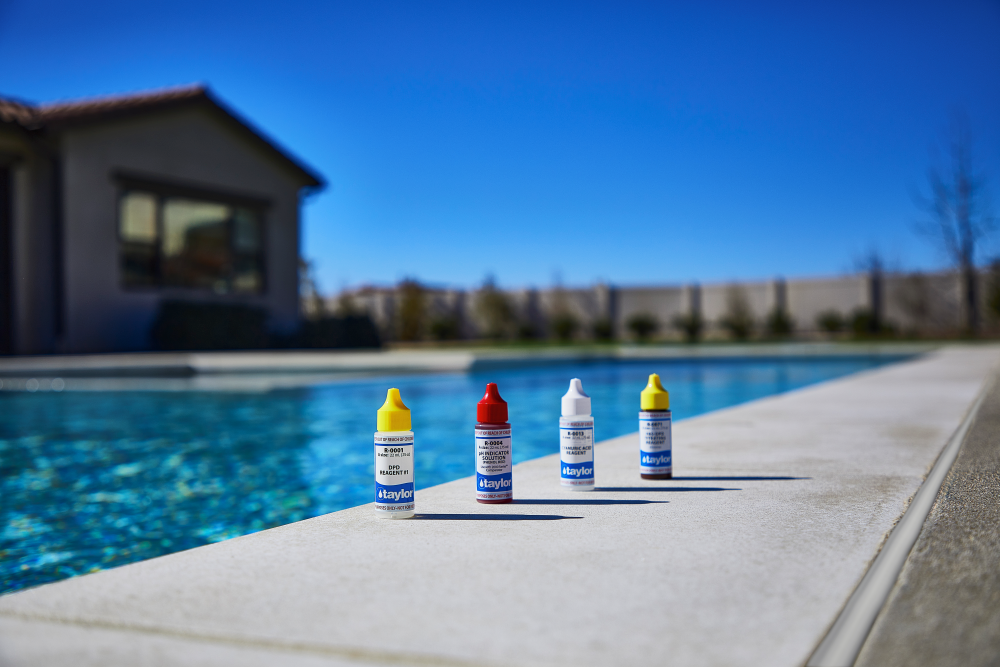Without a doubt, the most essential part of any pool or spa water test is the reagent. Reagents from Taylor are manufactured to order for freshness and quality in the Taylor Water Technologies facility outside Baltimore, Maryland and are formulated to remain effective for at least one year. It is a good practice to replace your test reagents in the beginning of each pool season.
Whether liquids, powders, crystals, tablets, or test-strip pads, all reagents are considered to be “perishables”. This means they have a shelf life and must be stored properly and replaced periodically.
How to Store and Maintain Reagents
As with all perishables, reagents are sensitive to environmental influences and will last longer under controlled conditions. Here are recommendations for proper storage of your reagents:
-
Keep test reagents and all chemicals out of reach from children and pets.
-
Store reagents at a consistent temperature in the range of 36°– 85°F (2°–29°C). Any extreme temperature fluctuations can cause reagents to deteriorate.
-
Keep reagents out of prolonged direct sunlight. (Note: This is why very light-sensitive reagents have brown plastic bottles to help protect them.)
-
Store reagents separately from treatment chemicals.
-
Replace caps immediately after use and tighten them carefully to limit exposure to air and humidity.
-
Do not switch bottle caps, place caps on dirty surfaces, or pour reagents into any other containers.
-
Avoid touching test strip pads.
How to Recognize Compromised Reagents
Degradation or contamination of reagents can lead to compromised test results. A reagent is suspect if it is not the color that you are used to seeing or if it has changed color significantly over time. The presence of new floating particles that do not dissolve when shaken could also be a sign that the reagent should be replaced.
Here are some signs to look for in specific pool reagents:
-
R-0002 DPD Reagent #2: This solution should be colorless to light or faint pink. As it ages, the indicator oxidizes and darkens to a dark brown or pink. Once this change has occurred, the reagent is no longer effective and should be discarded.
-
R-0003 DPD Reagent #3: This solution should be colorless. As it degrades, the color will become increasingly yellow.
-
R-0004 pH Indicator (Phenol Red): As it degrades, the solution may change from its original red color to a yellow or purple.
-
R-0011L Calcium Hardness Indicator: This solution should be a deep blue color. If it is any other color, it should be replaced.
-
R-0718 Silver Nitrate Reagent: This solution should be colorless. We recommend it be replaced on an annual basis.
A note about reagents that have frozen: A liquid reagent may still be effective after freezing. To find out, allow frozen reagents to thaw at room temperature — never heat in a microwave or in warm water. Carefully observe the bottle and dropper tip for cracks or leaks. Mix the thawed reagent thoroughly and observe for floating particles that do not dissolve when the bottle is shaken. If cracks or particles are present, you need to discard and replace the reagent.
Additional Reagent Rules and Recommendations
Reagents cannot be interchanged between test kit manufacturers. Even if the reagent name is the same, it may not be the same strength of ingredients. Phenol red is a good example of this. Taylor phenol red indicators vary in strength and are designed to work with the sample size of the specified Taylor color comparator. That's why R-0004 and R-0014 cannot be interchanged.
When purchasing individual reagents, it is advised to carefully consider the container size. Larger bottles may appear to be the better value, but if you do not use the contents in a year’s time you may risk exceeding the reagent’s useful life and compromising test results or end up discarding the unused portion.
For reference, Taylor’s dropper tips dispense 25 drops per milliliter. That means tests requiring 5 drops of reagent per test will get 110 tests from a .75 oz. bottle, or 300 tests from a 2 oz. bottle. Typically, homeowners are recommended to purchase .75 oz. reagent bottles. Larger sizes are available for professionals servicing multiple pools. Repouring from larger bottles (pints, quarts, or gallons) should be reserved for service professionals.

